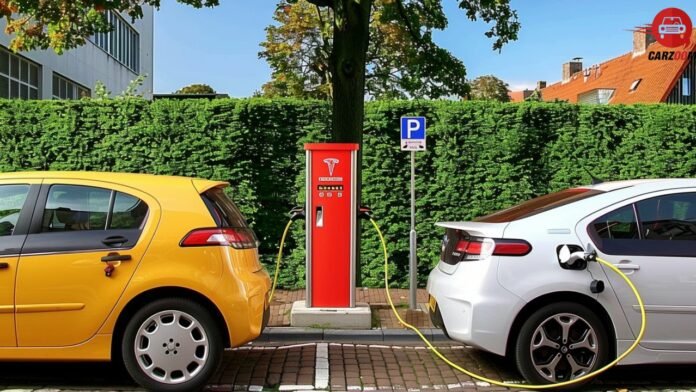The greatest number of electric vehicle (EV) rollouts will occur at Auto Expo 2025, as automakers including Maruti, Hyundai, Tata, JSW MG, and others prepare to display zero-emission cars at the prestigious biennial expo. According to sources, the Auto Expo 2025, which is set to take place in Delhi-NCR from January 17 to January 22, 2022, will witness the greatest number of product launches and unveilings in the Battery Electric Vehicle (BEV) segment. These include the mass-market EV, Tata Sierra EV & Altroz EV, BYD Seagull, MG Bingo, Mercedes Benz EQG, and Maruti Suzuki’s first e-car, which is based on the EVX Concept.
According to sources, the top seven passenger vehicle manufacturers—Maruti Suzuki, Hyundai Motor India, Tata Motors, JSW MG Motor, Kia India, and Mahindra and Mahindra (M&M)—are anticipated to introduce electric vehicles. Concurrent with the Auto Component display at Yashobhoomi in Dwarka, the government-organized Automobile Exposition will hold its next edition under the auspices of the Bharat Mobility Summit.
Automakers raise the bar for electric vehicles
The largest automaker in India, Maruti Suzuki, is prepared to introduce its first electric vehicle at the Expo. The nameless vehicle is said to cost more than Rs 10 lakh and have a 500 km (mile) range on a single charge. “We’re going to build an electric vehicle ecosystem in addition to launching our first e-car at the Bharat Mobility Summit in 2025,” Maruti Suzuki India Limited’s senior executive officer of marketing and sales, Partho Banerjee, recently told reporters. He made a suggestion that the vehicle will be placed in the mid-SUV (sports utility vehicle) market.
Hyundai Motor India Limited, the country’s second-biggest automaker, is getting ready to introduce the premium EV Ioniq 6 and the electric Creta SUV. The latter is expected to retail for about Rs. 65 lakh. According to a source, the corporation is also considering exhibiting the mass-market EV concept version that is being tailored for the Indian market. According to a second source, the Hyundai Inster, Tata Punch EV’s closest competitor in the micro-electric SUV market, is probably going to be on display at the occasion. A Hyundai representative, however, declined to offer any “comment on future products & technologies.”
Leading the local electric photovoltaic (PV) market at the moment, Tata Motors, plans to launch a range of BEVs at different pricing points. According to sources, the Tata Altroz EV, Tata Harrier EV, and Tata Sierra EV would be presented or introduced at the next auto show. There is also much speculation that the production model of the Tata Avinya concept will be unveiled alongside the new Range Rover Electric model from its British affiliate. A Tata Motors representative dodged questions about the launch specifics, though.
Another domestic automaker, M&M, is also thinking of showing its line of electric vehicles (EVs), which it had previously unveiled. These include the XUV.e8 electric form of the XUV7OO and Born Electric concept cars, BE09, BE.05, BE Rall-E, and XUV.e9. The firm is mum regarding its participation at the Expo, even though it will be revealing the XUV.e8 costs in early 2025. “We haven’t made any decisions regarding the matter yet,” a Moneycontrol representative for M&M stated.

Bingo will soon be available from JSW MG Motor India, which has already introduced a several EVs in the last two years. Bingo, a five-door e-hatchback that will be priced between Comet and Windsor and rival Tata Tiago directly, is expected to retail for between Rs 8.5 and Rs 10.5 lakh.Eve. Regarding the organization’s intentions for the event, a JSW MG Motor India representative declined to comment.
Despite the South Korean automaker’s absence of official announcement, Kia India might also display the concept mass-market EV at the exhibition. Moneycontrol emailed questions, but the corporation didn’t answer. VinFast Auto Limited, a Vietnamese electric vehicle manufacturer making its Expo debut, will have VF6, VF7, VF8, and VF9 on display. “VinFast confirms its participation in the event and will showcase its diverse, modern, and intelligent electric vehicles to the market,” the official spokeswoman stated. Additional information will be released when it is appropriate.
The lone Chinese automaker here, BYD, will debut the Seagull, its most affordable model. The e-hatchback is anticipated to go on sale in India later in the year and would cost less than Rs 10 lakh. Being a member of the Bharat Mobility Global Expo 2025 excites us. We continue to concentrate on the premium and luxury EV market as a global leader in electric mobility, providing environmentally friendly solutions that support India’s sustainability objectives. We won’t be able to comment on new product introductions at this time per corporate policy, a BYD India representative said Moneycontrol.
Mercedes-Benz India is getting ready to introduce the EQG, the electric G-Wagon, to the premium car market for about Rs. 3.5 crore. The EQC e-SUV, which is anticipated to premiere the following year, is also anticipated to be unveiled. According to insiders, the Concept EV EQXX, which can go 1,000 kilometers on a single charge and is being introduced in other markets, may be shown. According to a Mercedes-Benz representative, the business is currently assessing the opportunities for its involvement. Honda has announced that it will be introducing its first electric scooter into the two-wheeler market.
According to S&P Global Mobility, the Indian government requires original equipment manufacturers (OEMs) to pursue a technology-neutral course, ultimately aiming to decarbonize transportation throughout the country. The subject of Auto Expo 2025 will be powertrain pluralism, according to Puneet Gupta, director of S&P Global Mobility. Even though electric vehicles will be the main attraction, the event is probably going to introduce ideas and goods that highlight a variety of multi-fuel technologies, with an emphasis on electric and hybrid vehicles (PHEV & HEV). “The spike in electric vehicle launches by leading manufacturers will move India toward the inflection point, which is approximately 5%,” he continued.


